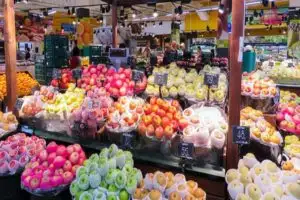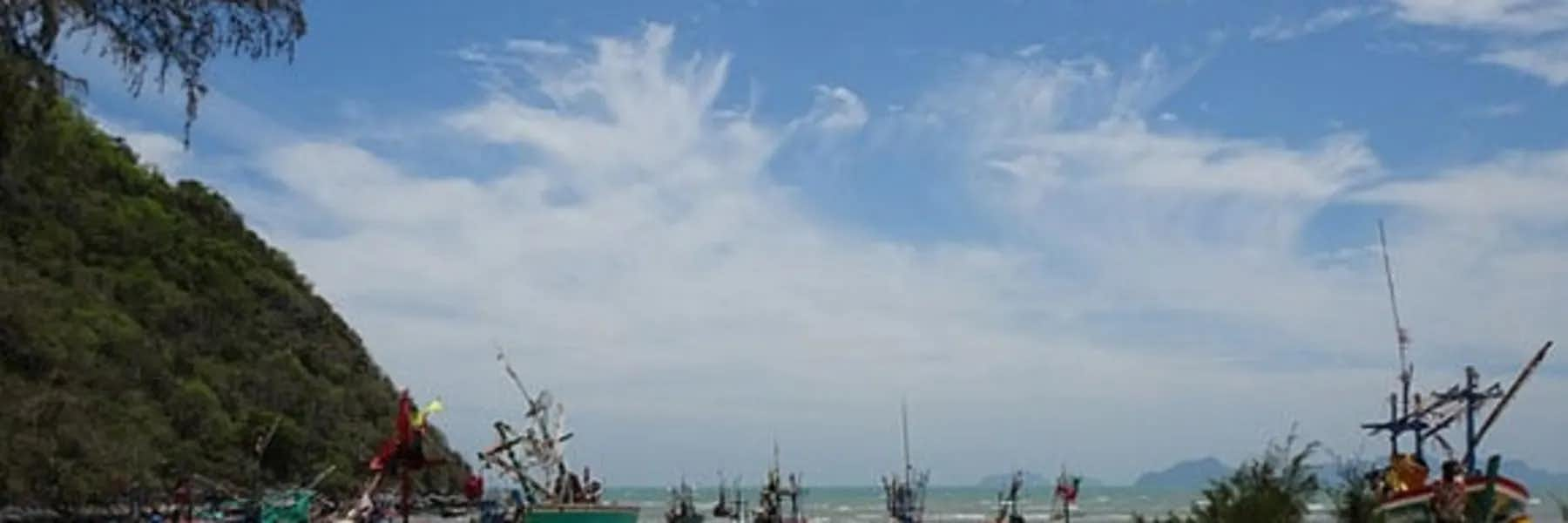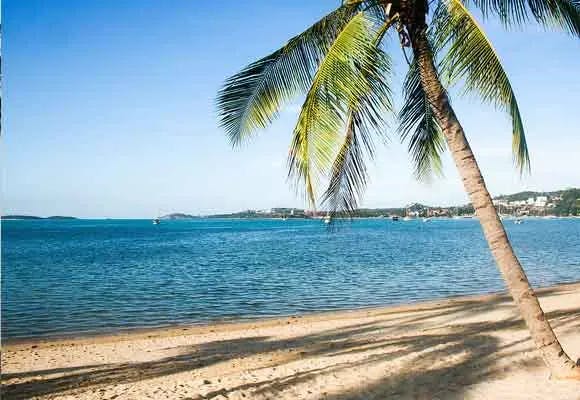Once a quiet fishing village, Hua Hin, Thailand became a popular summer getaway destination for Thais in the 1920s, when the Royal Family built their summer palaces there. Located on the eastern coast of the country and the shores of the Gulf of Thailand, it has year-round temperatures in the mid-80s F, making it a perfect beach getaway for those living in the sweltering chaos of Bangkok. By car or train, it is only about a four-hour journey, and with its population of about 85,000 people, it's laidback enough to feel like a beach town, but still has all the modern conveniences of any Western city.
Retire in Hua Hin

Although it’s a smaller scale city, Hua Hin is cosmopolitan with shopping malls, blockbuster movie theaters, and international grocery stores selling French wines and Norwegian salmon. But it’s still easy to find a quiet beach hideaway without a soul in sight. Hua Hin is quickly becoming one of Thailand’s premier golfing destinations, with seven different courses around the area and a few driving ranges to practice on. There is even an award-winning vineyard 45 minutes away, with elephants and a restaurant that overlooks its five acres of grapes.
There are local daily markets all over the city which are the freshest and cheapest places to buy your produce. If you can't grow it yourself, at least you know it's grown nearby, and you are helping to support the local community. There are, of course, many international grocery stores to get those imported goods that remind you of home, but they do come at a cost. Living here and buying locally is not just a good way to keep your cost of living down, it’s a good way to support local families.
Because the Royal family lives in Hua Hin at times, excellent healthcare is a requirement, so there is the JCI-accredited Bangkok International Hospital right in the center of town. Many of the doctors and nurses are fluent in English, so a lot of expats choose it for their network of physicians.
The city itself runs parallel to the beach, with fancy hotels and seafood restaurants lining it. The restaurant scene has benefited from Hua Hin’s international expats. Along the waterfront is a web of restaurants serving everything from fresh, right-off-the-boat seafood, to Indian and Greek food. Peppered in between the great restaurants are tons of bars and lounges, some with live music nightly.
While there is a sizeable number of expats living in Hua Hin, it’s not overrun and maintains a delightful mix of traditional Thai living with Western conveniences.
Lifestyle in Hua Hin

Living in Hua Hin won’t be boring. The four-mile-long, wide stretch of beach is known as a kite surfing destination during the windy months of February to April and October to January. With a few different schools to choose from, it’s a perfect place to learn the sport because of the shallow and calm waters of the Gulf. If the beaches don’t excite you, there is a new eco water park built into the jungle, Vana Nava, which has the largest waterslide in Thailand, as well as an infinity pool and surf simulators.
There is a lot to like about Hua Hin. You can chill out beach or poolside or take part in any of the many sporting and social activities on offer. Sticking to a healthy diet is easy here thanks to the abundance of fresh produce direct from markets at a fraction of the cost you’d pay in North America.
If golf is your game, you’ll have nine quality golf courses to choose from here, including several at international competition standard and all within 30 minutes’ drive of central Hua Hin.
You can also enjoy tennis, badminton, yoga, Muay Thai, fishing, bird watching, exploring nearby national parks where elephants roam free, and shaping up with fitness facilities to suit every preference and budget.
Watersports including kitesurfing, paddle boarding, and surf skiing are readily available. Add to that, two sizeable modern water parks to keep fun seekers, young and not so young, entertained all day.
Regular cultural events happen across the calendar year and include important Buddhist celebrations like Loy Krathong, Songkran (Thai New Year), and Visakha Bucha Day. Each celebration is treated with respect, color, ceremony, and fun; synonymous with the Thai approach to life.
Festival abound, from the International Kite Festival, an increasingly popular Jazz Festival on the beach, international tennis tournaments, Kite Surfing competitions, marathons and triathlons, grand opera in the park, food festivals, Harvest at the Vineyard, and more…
Hua Hin has an artsy side as well. The Artist Village, a co-op for local artists, offers classes for anyone wanting to learn new skills. Founded in 1998, each resident artist has their own space to work in and to sell their art. An increasing number of galleries are also opening in and around the old town. And on weekend nights, the Cicada Market showcases locally made crafts, live entertainment, and, of course, fantastically tasty cheap Thai eats.
Getting Around Hua Hin

Hua Hin is about 120 miles south of Bangkok and can be reached by car, bus, and train. Hire a private, air-conditioned car for around $50, or take the perfectly comfortable bus for around $10. There is also onward travel by bus and train to the south, including to Malaysia, Thailand’s nearest southern neighbor.
Hua Hin has an international airport with Air Asia offering direct flights between Hua Hin and Kuala Lumpur (KL), and from there, to the rest of the world.
Getting around Hua Hin is relatively easy with plenty of tuk tuk’s, taxis, and local buses (songthaew) that ply the main road networks. Most expats purchase or rent a vehicle, mainly when living away from the transport routes.
Climate in Hua Hin
The Hua Hin region offers real tropical living, with daytime temperatures averaging84 F to 93 F with the sea breeze adding a refreshing effect.

The year begins with the dry, cooler season from December to March before the hot and monsoon season arrives in April. Rains ease somewhat from June to August before the most torrential falls begin in September and continue through November.
During the wet season, there may be an afternoon storm every few days which calm things down a bit. In saying that, Hua Hin is one of the driest in Thailand and the rains are welcome.
Cost of Living in Hua Hin
Many expat couples in Hua HIn live comfortably on $2,000 a month—some for a little less. This is based on a couple renting a one- or two-bedroom house or apartment. This would cover an active lifestyle, eating out a few times a week, buying groceries, and taking advantage of entertainment options around town.
Housing options include luxurious beachside living or drive just a few miles out of town for a more rural setting—and more affordable options.
Conversely, $5,000 a month would see a couple living a very comfortable lifestyle including having many of their favorite imported goods and include dining out and traveling.
Here’s a run-down of some average costs:
| Expense | U.S. $ |
|---|---|
| Rent (furnished, two-bedroom apartment or house) | $576 |
| Groceries | $300 to $428 |
| Entertainment, eating out (1-2 times a week) | $178 to $285 |
| Electricity (limited A/C), water (town supply) | $71 |
| High-speed internet | $21 |
| Pay TV (True Visions Gold package) | $48.50 |
| Phone (standard mobile phone data plans for 2 people) | $17 |
| House cleaner (four hours $20; once a fortnight) | $28 |
| Transportation (maintenance and fuel for the four-cylinder sedan) | $115 |
| Incidentals | $107 |
| Total | $1,480.50 to $1,715.50 |









